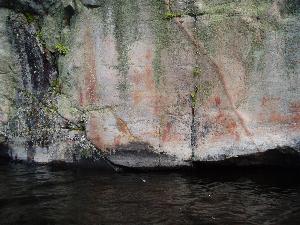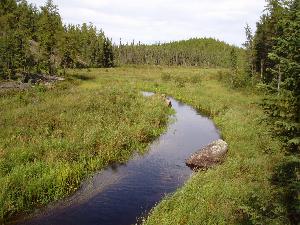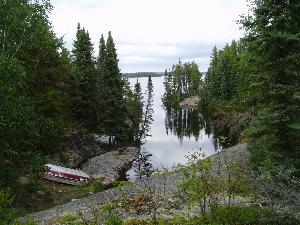This document contains "additional comments" and is part of the Issues and Options Questionnaire for the Woodland Caribou Signature Site submitted by James Hegyi.
To the Advisory Committee and to the First Nations Working Group:
My name is Jim Hegyi. I'm a canoe traveler from Milwaukee, Wisconsin. For the past ten years I've been an annual guest in your Woodland Caribou Provincial Park. I've spent a rainy night in the cabin of a kind family on Murdock, had lunch with the Heino's on their patent land island, and just last year met a very kind resort owner who allowed me to catch a plane from his dock on Gammon.
 I watched the sunset reflect off the water and throw ripples of light on the pictograph rock on Artery and after slogging through the awful Artery portage, met a young woman who's test of leadership was to guide a group of younger teenagers through the same tough route. I've come to realize that just about everyone I met in the park shares my deep appreciation of wild, unspoiled land. We are - all of us - outdoors people, and we're drawn to this same unique, distinctive and special place.
I watched the sunset reflect off the water and throw ripples of light on the pictograph rock on Artery and after slogging through the awful Artery portage, met a young woman who's test of leadership was to guide a group of younger teenagers through the same tough route. I've come to realize that just about everyone I met in the park shares my deep appreciation of wild, unspoiled land. We are - all of us - outdoors people, and we're drawn to this same unique, distinctive and special place.
Although Woodland Caribou Park is an excellent place for a foreign canoe traveler to spend a few weeks, I've come to realize that the park isn't there so that I, or any group of people can have a great vacation. The long-term protection of the natural and cultural features of the park supercede any desires, needs or perceived rights of any visitor. The good people of Ontario have decided that they will not develop, use up, change or exploit this signature site. The people of Ontario have decided to preserve and protect this historical, geological and naturally beautiful place.
The park management plan may mean that my future travels in the park will carry restrictions and rules that I will obey. I will gladly defer my personal preferences to a management plan that insures that my grandsons may someday have the opportunity to enjoy your park as I have over the last ten years.
Some of the features of the park that I appreciate are:
-
The sound of a distant waterfall that rises and fades on the wind.
-
A spectacular view - like the view from the high side of the geological divide between Gammon and Royd lake.
-
 A primitive shore or channel not cleared or improved or marked by man's presence.
A primitive shore or channel not cleared or improved or marked by man's presence.
-
A chance encounter with caribou while walking a portage - that one second of time, a flash of brown and white, that lasts in memory for a lifetime.
-
The appreciation of people that lived here long ago. No amount of reading or study compares with the moment when your canoe rests in front of a pictograph site. The emotional impact of being in the same spot, surrounded by the same wild land that hasn't changed for thousands of years is a fragile signature site feature that exists in very few places.
-
The sense of remoteness - of being far from civilization. Some places within the park are remote and can be visited only after dozens of portages have been traversed.
-
The abundance of fish, the possibility of catching a meal without a flasher to find structure or long hours of searching.
Since I believe that most of the visitors to the park share an appreciation for wild, unspoiled land, I believe that any park plan should address the issues necessary to preserve the features that I listed above.
-
To preserve quiet evenings, generators should be equipped with the best noise limiting exhaust system available. If this cannot be done, then alternative energy sources that do not make noise should be used within the park.
-
 To preserve the scenery, cached boats should be re-located to landings that are off of the main routes. If they are pulled into the brush out of sight, there will be little conflict between the traveler who enjoys the scenery or wants to take photographs and the facility based fisherman that needs to access another lake.
To preserve the scenery, cached boats should be re-located to landings that are off of the main routes. If they are pulled into the brush out of sight, there will be little conflict between the traveler who enjoys the scenery or wants to take photographs and the facility based fisherman that needs to access another lake.
-
To preserve the primitive shoreline, markers (flagpoles, rocks painted white, brightly colored rooftops) should not be used to make it easier for boats to find their base. Although an orange ribbon makes it easy for canoe travelers to find portage landings, these too should be removed. Plastic bottles used to mark the route through shallow water or to mark fishing spots don't belong in a wilderness park.
-
To preserve the caribou herd and other wildlife, nature reserves should be established and their regulations enforced.
-
Pictograph and archeological sites should receive special protection. In particular, the site on Artery Lake and the site on the northern part of Murdock should be protected from noise. Travelers going west should land beyond Artery Lake and Travelers going east should land before Artery Lake.
-
Some part of the park must remain remote so that our young people can test their resolve and leadership skills to reach these areas. Some area must be difficult to get to so that the visitor feels a sense of accomplishment in reaching the area. There must be a reward for making it to this remote area - no visible sign of man.
-
The abundance of fish should be preserved at a high level. If fishing is degraded until electronics are required to find structure or excessive travel is needed to get to the concentration areas, the result will be more travel and less enjoyment for all visitors.
-
Canoe travelers should be instructed to avoid and respect private property within the park – to limit contact with lodge visitors that want their own solitude.
Visitor Education - a most important part of the park management plan:
Let me re-state what I stated before. I believe that just about everyone I met in the park shares my deep appreciation of wild, unspoiled land. We are - all of us - outdoors people and we're drawn to this same, unique, distinctive and special place. I truly believe that almost all park visitors will work together if they know and understand the reason for the park management plan.
I believe that the Advisory and Working Groups should recommend compulsory education for all visitors entering the park. Many of the actions that will reduce conflict between visitors - actions that will help preserve the natural and cultural features of the park, are easy to implement if everyone knows what to do and what not to do. A compulsory video presentation or questionaire will impress visitors with the importance of their actions and make them understand the expectations of park officials and other visitors.
I would like to thank you, the members of the Advisory and Working groups, for spending your valuable time to insure that future generations will have the good land that you have today.



